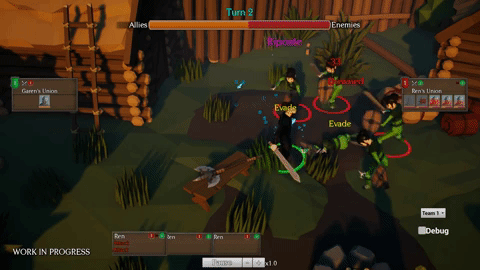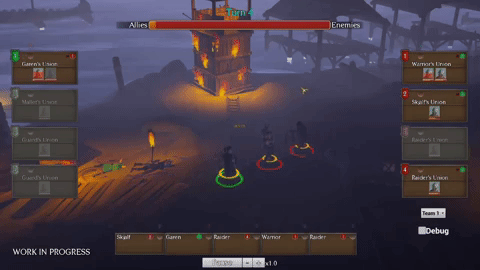Introduction
Welcome to the first Project Shore devlog!
We have been working on the game for almost half a year now, and as it is getting close to what we like to call “alpha” here, I would like to talk more about it and the features we’re including.
But first, what exactly is Project Shore? Put simply, it’s a turn-based tactical RPG game where you play the role of a mercenary company leader in a medieval fantasy world. Now, most of our readers have probably played an MMORPG before, and some of them may even have the experience of leading a group of other people. What if we took that experience and made it a core part of a story-based single player game? That is the goal of our game. And we have shaped our game systems accordingly:
- Battles are small scale and simple early on but grow in complexity and size as the player progresses.
- Combat features an indirect control system: you give general orders to your units (attack that target, support this target, wait and prepare, and so on), and individual characters perform appropriate actions while reacting to the ever-changing situation on the battlefield.
- Characters generally get better at what they do. Equip a mage with a greatsword and you’ll see him build physical strength and unlocking new skills with the weapon, although his magical prowess will not grow as much. You, as the leader, can affect character progression by choosing their equipment, managing their action skill lists and training them in specific tasks as a coach of sorts, but there is no direct skill allocation.

Combat
Now to talk about the meat of the game – its combat system. But first, lets see how it looks and plays!
I mentioned earlier that you give orders to characters, but imagine having to command 18 of them, each turn, to attack the enemy. Quite boring and not very realistic, isn’t it? So, in our game you are giving orders to groups of characters rather than individuals. These groups we call Unions. You start with one Union. You’ll command up to five later in the game. One Union can be used to group up to five characters, but one character is still a Union, too. When you order a Union to attack a target (which, incidentally, is another Union), what you really do is order all the characters this union consists of to perform an offensive action against the target. This affects gameplay in several important ways, and here’s the biggest deal: you don’t have to scroll through a list of spells, or look for an ability on the character’s action bar anymore. The characters do that for you using their heads (well, AI and a bit of weighted random). Your role, as a player, is shifted to giving the right orders at the right time in battle. You’ll still manage their spellbooks in a way, but only out of combat, to make sure they aren’t using what you don’t want them to use. But we’ll talk more about character customization in another post.
So, the characters have a certain degree of freedom in what they do with your orders as their leader. Here’s how it works.
First, abilities directly corresponding to the order will always be prioritized. If you give a Union an order to heal in front of an angry mob, that is exactly what the characters in will do, and consequences be damned – but only assuming the characters have any healing skills.
Things get interesting when conditions like knowing the appropriate skill for the task come into play. Going back to the previous example: you gave an order to heal while engaged with an enemy to a Union consisting of Dude A and Dudette B, but only Dudette B knows how to heal. Will Dude A just stand there and watch helplessly as the enemy approaches? Well, no. The ability assessment system will kick in, making Dude A cycle through his available skills to find one most suitable to the given task. And assuming Dude A knows no support skills whatsoever, he’ll do the simplest thing and try to hit the terrible foe in the face using whatever he has equipped. So yes, you can absolutely use that Healing order targeted at an enemy and rest assured that your healers will still heal friendlies and offensive characters will still attack the enemy.
What exactly drives the availability of certain orders and individual ability usage? The first thing that comes into play is the characters’ action resource, Preparation Points (or PP). Each character has a stat called Preparation which determines how many PP the character receives each turn. Any ability costs PP to use, starting with 1, and naturally characters cannot use abilities they can’t afford. Pretty simple, right? You are, however, giving orders to a Union, which can consist of characters with different Preparation values and current PP pools. Imagine strategically ordering around a group of Hearthstone players if you will.
Each Union generates an order list appropriate for each target, depending on this target’s allegiance (ally/foe) and abilities of each character within this Union. Order is this general thing that says, do this kind of action (attack/heal/buff/debuff) and use this up to this number of PP.
Until today’s combat update, you could give your Unions orders they could not carry out on their next turn. For example, you’d have a Union where each character had 1 PP and give them an order to milky drill punch the enemy for 3PP. You kind of know they’d try to milky drill punch because milky drill punch is the only ability they know that costs 3PP, but anyways. So you queued the order called “3PP Attack 2T” (actual in-game text).
Let’s assume these characters only have Preparation values of 1 too, meaning that they’d need to, well, prepare for 2 more turns to reach 3PP and milky drill punch the enemy. Any number of things could happen during those 2 turns: the target could get wiped out by others, or the targeting Union could get intercepted. It was also kind of difficult to track for you, the player. And not to mention that the game utilizes a positioning system for Unions and a morale system (more on those in one of the later posts), which make it very important for Unions to be in the right place at the right time instead of just standing there charging their milky drill punches.

Post-Update
Think back to that allegory of controlling five Hearthstone players. That was the idea behind the change.
In Hearthstone, you don’t channel and wait for your mana to reach a certain point to cast a spell. You have a fixed limit you can use each turn, and that’s what you do. Or don’t, but the cards are the limiter in this case.
Now, in our game you don’t look at each character’s cards (skills) before they perform an action, but we want you to be able to easily keep track of active Unions and predict characters’ actions. So, here’s what changed:
- Only the orders which can be performed next turn are shown in the list. No more queueing for a 3-turn action and waiting for the milky drill punch to happen. And no more decoding the order names: you will only see the cost of the order and its type.
- Abilities are now separated into two categories: PP generators and PP spenders. Whereas before you had to decide between using a 1PP basic attack to get to the enemy quicker or waiting for a heavy hitter to charge, now it’s (almost) always worth it to order your Unions to act. The 1PP skills generally are low damage, but they allow you to control the battlefield and are cost-neutral (refunding the 1PP it costs to use it or even giving a PP bonus if the character’s Preparation is higher than 1).
- Speaking of limiters: we decided to reduce characters’ decision making freedom a bit. Before the update, characters could in some case use more PP for an action than was specified in the order. For example, if the character was ordered to attack using a 1PP order, they’d still use a 2PP action sometimes in combat if they had points to spare. For now, we disabled this behavior completely, so what you select is what you get. While in certain cases this change might be detrimental to characters’ performance in battle, we thought the clarity it provides to the player was more important.
So that’s it for now! The game is approaching an important milestone in August as we are about to start showing a playable demo to people, and we want to make sure it’s in the best shape when we do.
In the following articles, we’ll explore other topics related to combat: morale, character progression, positioning and the philosophy behind ability design.



It sure looks an fantastic game I wonder when its available am so hyped.